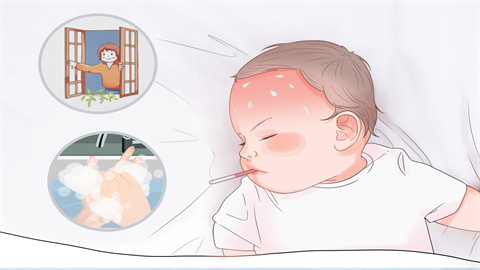Why does a two-year-old child have cold hands and feet when they have a fever?
Generally speaking, fever refers to an elevated body temperature. A two-year-old child experiencing cold hands and feet during a fever may be caused by factors such as the body's temperature regulation mechanism, poor peripheral circulation, common cold, roseola infantum, sepsis, and others. If there are any signs of discomfort, seek medical attention promptly and undergo symptomatic treatment under the guidance of a qualified physician. The detailed explanations are as follows:

1. Temperature Regulation Mechanism
The thermoregulatory center of a two-year-old child is not yet fully developed. When body temperature rises, blood is redistributed to protect vital organs, prioritizing flow to areas such as the heart and brain. This may reduce blood flow to the extremities, causing cold hands and feet. It is important to keep the child warm and avoid prolonged exposure to cold environments. Adjust clothing appropriately according to weather conditions.
2. Poor Peripheral Circulation
A child's peripheral circulatory system is relatively weak. When body temperature rises, peripheral blood vessels are more likely to constrict to reduce heat loss, resulting in cold hands and feet. It is recommended to gently massage the child's hands and feet to promote circulation and engage in regular outdoor activities to strengthen overall physical health.
3. Common Cold
A common cold is usually caused by viral or bacterial infection. Pathogens invading the upper respiratory tract can cause inflammation, potentially leading to fever and cold extremities in a two-year-old child. Symptoms may also include coughing and a runny nose. Treatment may include medications such as oseltamivir phosphate granules, paracetamol oral solution, and isatis root granules, as directed by a physician.
4. Roseola Infantum
Roseola infantum is caused by human herpesvirus 6. Viral infection may lead to high fever, while the thermoregulatory center's response may reduce blood flow to the limbs, causing cold hands and feet. Symptoms may also include vomiting and diarrhea. Treatment may include ribavirin granules, ibuprofen suspension drops, and oral rehydration salts (Ⅲ), as prescribed by a doctor.
5. Sepsis
Sepsis is an acute systemic infection caused by bacteria entering the bloodstream, multiplying, and producing toxins. It may trigger a severe inflammatory response, leading to high fever. The toxins may also cause peripheral circulatory failure, resulting in cold extremities. Other symptoms may include rash and enlargement of the liver and spleen. Treatment may involve medications such as amoxicillin-clavulanate potassium for oral suspension, cefotaxime sodium for injection, and meropenem for injection, as advised by a doctor.
In daily care, ensure appropriate clothing or covering to keep the child's limbs warm, but avoid excessive bundling. Monitor body temperature closely and ensure timely hydration.




